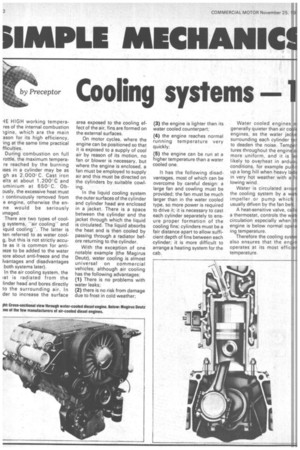Cooling systems
Page 46

If you've noticed an error in this article please click here to report it so we can fix it.
-IE HIGH working temperares of the internal combustion igine, which are the main ason for its high efficiency, :ing at the same time practical fficulties.
During combustion on full rattle, the maximum temperare reached by the burning ises in a cylinder may be as gh as 2,000'C. Cast iron elts at about 1,200j C and uminium at 650C. Obously, the excessive heat must continuously removed from e engine, otherwise the enne would be seriously imaged.
There are two types of coolg systems, -air cooling" and iquid cooling". The latter is ten referred to as water coolg, but this is not strictly accute as it is common for anti?,eze to be added to the water lore about anti-freeze and the 'vantages and disadvantages both systems later).
In the air cooling system, the 'at is radiated from the linder head and bores directly to the surrounding air. In der to increase the surface area exposed to the cooling effect of the air, fins are formed on the external surfaces.
On motor cycles, where the engine can be positioned so that it is exposed to a supply of cool air by reason of its motion, no fan or blower is necessary, but where the engine is enclosed, a fan must be employed to supply air and this must be directed on the cylinders by suitable cowl'ing.
In the liquid cooling system the outer surfaces of the cylinder and cylinder head are enclosed in a jacket. There is a space between the cylinder and the jacket through which the liquid is circulated. The liquid absorbs the heat and is then cooled by passing through a radiator before returning to the cylinder.
With the exception of one notable example (the Magirus Deutz), water cooling is almost universal on commercial vehicles, although air cooling has the following advantages: (1) There is no problems with water leaks; (2) there is no risk from damage due to frost in cold weather, (3) the engine is lighter than its water cooled counterpart; (4) the engine reaches normal running temperature very quickly; (5) the engine can be run at a higher temperature than a water cooled one.
It has the following disadvantages, most of which can be overcome by careful design: a large fan and cowling must be provided; the fan must be much larger than in the water cooled type, so more power is required to drive it; it is necessary to cast each cylinder separately to ensure proper formation of the cooling fins; cylinders must be a fair distance apart to allow sufficient depth of fins between each cylinder; it is more difficult to arrange a heating system for the cab. Water cooled engines generally quieter than air c engines, as the water fa surrounding each cylinder to deaden the noise. Tern tures throughout the engin more uniform, and it is likely to overheat in ard conditions, for example pu up a long hill when heavy I in very hot weather with a lowing wind.
Water is circulated ar the cooling system by a impeller or pump whic usually driven by the fan be A heat-sensitive valve, c a thermostat, controls the circulation especially when engine is below normal op ing temperature.
Therefore the cooling sy also ensures that the en operates at its most effic temperature.










































































































